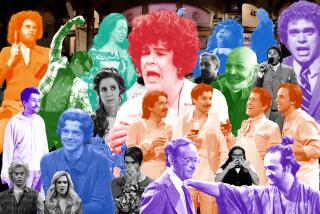A FUNNY SORT OF PLACE
They say that explaining a joke kills what’s funny about it. But every day, television’s top comic writers have to do exactly that. No, not kill their jokes -- but plan them out, break them down, go over them dozens of times and then fit them all into 21 minutes and 35 seconds of air time. Give or take.
And when it comes to the mechanics of sitcom assembly, it’s rarely a rote process. Each show has its own style, flair and tolerances. But if there’s one thing virtually any sitcom just can’t do without, it’s the writers’ room.
“On ‘Two and a Half Men,’ it’s critical,” says Chuck Lorre, who oversees two CBS hits -- the 6-year-old “Men” and the 2-year-old “Big Bang Theory.” “We’re basically the same staff for the last six seasons, and several of us go back 15, 20 years. We have a real shorthand with each other because we’ve been doing it for so long together, and there’s no way the show functions without a determined staff of professional comedy writers.”
At NBC’s “The Office,” the writers’ room consists of 10 to 12 scribes batting around ideas, arcs and characters. After a while, they split off and return with stories worth pitching; the room is then responsible for picking out the best items from that process (pending show-runner approval).
“We’re not bound by a formula,” says Paul Lieberstein, who plays Toby on the show and is co-show-running with Jennifer Celotta and Greg Daniels while Daniels turns his attention to NBC’s new “Parks and Recreation.”
Adds Lieberstein, “Or if we do, it’s very subtle -- we try to tell a comedy story, and if there’s a romance story we tend to let that fall into the background, though we’ve broken that rule several times.”
Many “Office” hours are devoted to projecting longer arcs or shaping the next 13 episodes or so -- but no further. “We don’t want to box ourselves in by planning out the entire season,” Celotta says.
That may explain why “The Office” rarely leaves its big, climactic moments for a finale -- this season, the show has featured no fewer than four high points that other series might have used as season-enders.
That said, “The Office” had 28 episodes this season, a large order. “We do really want dynamic things to happen at the end of seasons, but this way we get to have our cake and eat it too,” Celotta says. “We just know we’ll come up with another cool idea to end the season.”
Then there’s the issue of freestyle. On some shows, ad-libbing is verboten: “We’re putting on a play, and the rules of the road for plays are the writers do their jobs and make sure the material works,” Lorre says. “It’s not up to the actors to fix the material. If we can’t fix it, it ain’t fixable.”
Tina Fey, who runs NBC’s “30 Rock,” has a more laissez-faire attitude toward script alterations, noting, “Every now and then we ad-lib, usually at the tops and tails of scenes. Sometimes the actors will pitch alternate jokes on the floor, but we always cover the scripted material and a few alternates. We still shoot the show on film, so there’s not a lot of time to rewrite on the floor.”
Ah, yes, the constant ruler of any sitcom: time. Says Lorre, “The shows seem to get shorter every year, in terms of the airtime you have. But your writing has to accommodate that -- it has to be to the point, there’s not a lot of room for letting the scene ramble a bit.”
It’s something Fey has had to get used to. “This is my first experience in half-hour, so dealing with act breaks and stuff, this is the only way I’ve known it. But the running time of the show is a real challenge. If there were a way to get one more minute, that would be great.”
Thanks to having fewer lighting setups than most shows, “The Office” has extra time to do more takes -- up to a dozen for each scene, with six devoted strictly to the script and six that are looser. Says Lieberstein, “Often, some really brilliant stuff emerges.”
That’s the goal for any comedy assembly line -- not to just make it funny but to make it memorable and maybe even brilliant. “Our hope is to do things that feel real and not, not sitcom-y,” Celotta says. “There are a lot of fantastic sitcoms on the air, but this is half sitcom and half documentary. After five seasons, I’ve been able to notice these characters grow -- they change and evolve, which is the advantage of the documentary format. That just makes it more interesting.”
And hopefully funny.
--
More to Read
The complete guide to home viewing
Get Screen Gab for everything about the TV shows and streaming movies everyone’s talking about.
You may occasionally receive promotional content from the Los Angeles Times.






